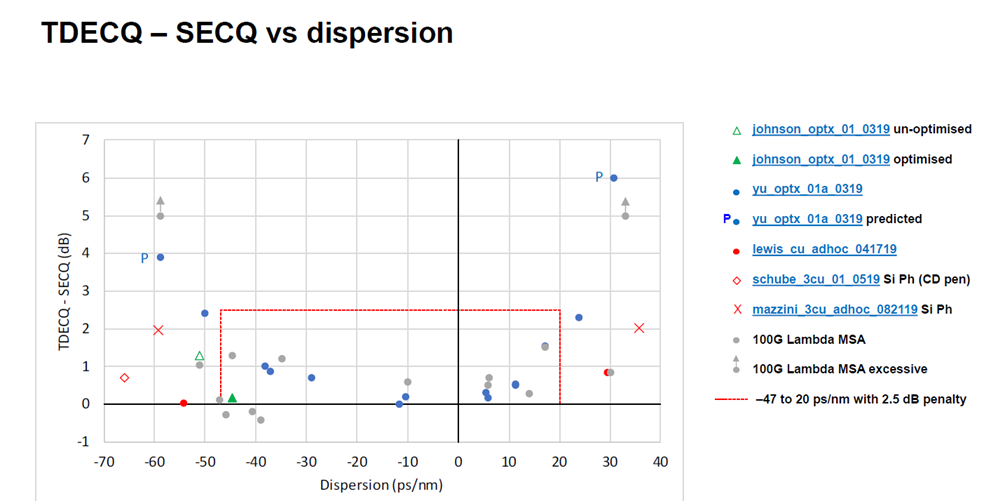Hi Scott,
This was the email I sent on 22 March.
Let me show specifically the fairly consistent curve of aggregated test results 100G PAM4 dispersion penalties shown in
https://www.ieee802.org/3/cu/public/Sept19/stassar_3cu_01_0919.pdf of CD penalty versus CD.

A lot of test results came from the 100G Lambda MSA work.
As you can see, for 30+ ps/nm the CD penalty goes above 4 dB and for 50 ps/nm it would go off the screen.
This is quite different from your claim of 0.5 dB for 50 ps/nm.
These results were used in the cu project to define the limits for 400GBASE-LR4-6.
Generally it’s my experience that simulations of dispersion penalty do not provide sufficiently reliable results to support choices for wavelengths.
Kind regards
Peter
From: Peter Stassar
Sent: Monday, March 22, 2021 4:43 PM
To: STDS-802-3-B400G@xxxxxxxxxxxxxxxxx
Subject: CWDM dispersion levels
Hi all,
I just pulled up my G.652 fiber dispersion Excel sheet to calculate the worst case dispersion numbers for the 8 CWDM channels mentioned by Scott in his presentation.
Conventional CWDM4 dispersion levels, taking into account conventional tolerance of +/- 6.5 nm:
1271 nm channel: -5.87 ps/nm.km
1331 nm channel: +3.3 ps/nm.km
Additional CWDM channels:
1351 nm channel: +4.96 ps/nm.km
1371 nm channel: +6.55 ps/nm.km
1391 nm channel: +8.07 ps/nm.km
1411 nm channel: +9.54 ps/nm.km
As one can see, from 1331 nm to 1411 nm the chromatic dispersion coefficient increases from 3.3 ps/nm.km to 9.54 ps/nm.km which is almost x3, which is quite significant.
The test results from the 802.3cu TF were contained in
https://www.ieee802.org/3/cu/public/Sept19/stassar_3cu_01_0919.pdf.
As I clarified, I believe the group would be interested to see test data how tripling the amount of dispersion in a CWDM8 configuration could be established without a strong increase of dispersion penalty (TDECQ minus TECQ).
Kind regards,
Peter Stassar (Huawei)
To unsubscribe from the STDS-802-3-B400G list, click the following link: https://listserv.ieee.org/cgi-bin/wa?SUBED1=STDS-802-3-B400G&A=1